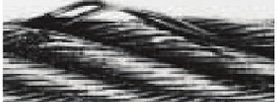|
1 |
Mechanical damage due to rope
movement over sharp edge
projection while under load. |
 |
8 |
Typical wire fractures
as a result of bend fatigue. |
 |
|
2 |
Localized wear due to abrasion
on supporting structure. |
 |
9 |
Wire fractures at the strand,
or core interface, as distinct
from “crown” ractures. |
 |
|
3 |
Narrow path of wear resulting
in fatigue fractures, caused
by working in a grossly
oversize groove, or over
small support rollers. |
 |
10 |
Break up of IIWRC resulting
from high stress application. |
 |
|
4 |
Two parallel paths of broken
wires indicative of bending
through an undersize groove
in the sheave. |
 |
11 |
Looped wires as atresult of
torsional imbalance and/or
shock loading.
|
 |
|
5 |
Severe wear, associated
with high tread pressure. |
 |
12 |
Typical example of localized
wear and deformation. |
 |
|
6 |
Severe wear in Langs Lay,
caused by abrasion. |
 |
13 |
Multi strand rope “bird caged”
due to torsional imbalance.
|
 |
|
7 |
Severe corrosion. |
 |
14 |
Protrusion of rope
center resulting from
build up of turn. |
 |
 |
